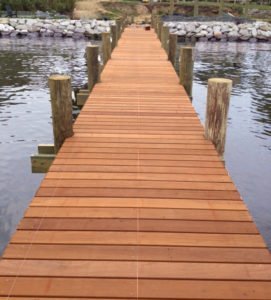 Its getting cold out there. The summer tourists have gone home and seasonal repairs and renovation has begun in earnest. This year one simple yet highly effective repair you can do is to replace your dock boards with Ipe. After all a dock is just a deck right? In fact Ipe has become such an effective dock material that many of the sawmills we work with in Brazil produce 4-5 foot Ipe boards that are ready for dock installation. The surface boards on a dock take heavy punishment from direct sunlight all day, wind and water, and the occasional spilled bucket of chum. Ipe is maybe one of the best wood species out there to take this abuse and it doesn’t hurt that it is beautiful looking either.
Its getting cold out there. The summer tourists have gone home and seasonal repairs and renovation has begun in earnest. This year one simple yet highly effective repair you can do is to replace your dock boards with Ipe. After all a dock is just a deck right? In fact Ipe has become such an effective dock material that many of the sawmills we work with in Brazil produce 4-5 foot Ipe boards that are ready for dock installation. The surface boards on a dock take heavy punishment from direct sunlight all day, wind and water, and the occasional spilled bucket of chum. Ipe is maybe one of the best wood species out there to take this abuse and it doesn’t hurt that it is beautiful looking either.
There is another benefit at play here that really makes this a compelling upgrade for your dock. Short 4-5′ Ipe like this runs cheaper per linear foot than you could expect for the more traditional 8-22′ decking boards. In many instances these shorter dock boards are the by-product of the primary product the sawmills produce. Also boards that don’t meet the expected A grade and are listed as B grade only have a few spots that contain defects. When those are cut away they are essentially A grade but cannot be listed that way due to the shorter length specification. So in the end you get a board priced as “rustic” or B grade Ipe that has the same quality appearance as an A grade Ipe decking board. This isn’t always the case for every dealer so do your homework and verify just how much B grade material will be found in the dock boards.
Non Slip Surface?
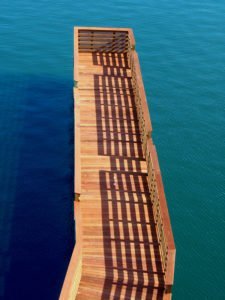 It has become relatively common to see a non slip or grooved, water shedding profile milled into these dock boards. I won’t deny that a little extra texture on the surface will aid in traction, but I think this may only be needed in inclined areas like the gangway on a floating dock or steps. Unlike some other tropical species, Ipe isn’t super oily and slippery (especially when wet) so the additional milling may be overkill. Moreover, the smooth surface will feel great to bare feet during the summer months. We offer both options which is unusual as many of our competitors bring their dock material in already milled with the reeded, non slip texture.
It has become relatively common to see a non slip or grooved, water shedding profile milled into these dock boards. I won’t deny that a little extra texture on the surface will aid in traction, but I think this may only be needed in inclined areas like the gangway on a floating dock or steps. Unlike some other tropical species, Ipe isn’t super oily and slippery (especially when wet) so the additional milling may be overkill. Moreover, the smooth surface will feel great to bare feet during the summer months. We offer both options which is unusual as many of our competitors bring their dock material in already milled with the reeded, non slip texture.
Between you and me some sawmills add this texture automatically as a way hide a lower grade.
Since we have a millworks on site, we can mill the reeded or grooved texture to order for your entire order or just part of it if you choose to add the texture to the inclined surfaces. It’s your dock so it’s your choice how you want it to look.
What Does it Cost?
That’s the big question isn’t it. I hate to say it but the answer is “it depends“. Certainly quantity comes into play and the more you buy the lower the linear foot price. Also the time of year you buy can make a big difference. Since Ipe shipping is largely dependent on the rainy season in Brazil, dealers in the US have to buy their entire year’s worth of material all at once. Quality and quantity will vary and during the late fall and winter our yard is flush with Ipe that is of the highest quality yet the market is flush with material so prices will be lower. The converse will be true during the summer months when the supply starts to wane and demand remains. We buy Ipe from all over Brazil and are able to maintain a more consistent cost throughout the year but regardless of when and how much you buy Ipe shorts can run between $.50 – $1.50 cheaper per linear foot!
So if you have been thinking about some maintenance on that dock or even installing a new dock, don’t shy away from Ipe since it is one of the most weather resistant and durable species on the market and you will get your dock board cheaper than the typical decking boards. Right now we have over 7,000 pieces of 5/4×6 or 1×6 dock boards in 4-5′ lengths. Give us a call or send us a request for quote and we can get back to you right away and deliver right to your door nationwide.

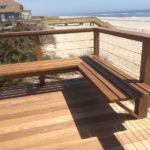
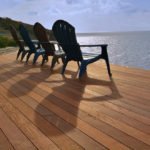
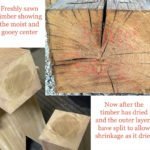
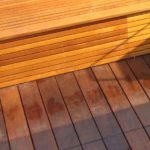
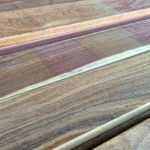
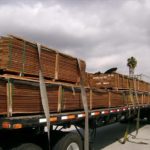


I discovered ipe as a very good less expensive substitute for ebony for guitar fretboards, bridges, tailpieces. It has the density and stiffness and is locally available; I use the darkest quarter sawn pieces I can find. On short necked instruments I don’t need an adjustable truss in the neck; an ipe insert with the fretboard provides plenty of stiffness esp. bonded with epoxy. Good for sound transfer as well. Ipe bordered with ebony is quite elegant as an option.